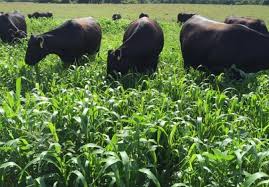Agriculture Notes On – Forage Crops – For W.B.C.S. Examination.
কৃষি নোট – চরাঞ্চল ঘাস ফসল – WBCS পরীক্ষা।
Agriculture as an optional subject is useful from numerous points of view. A decent hold over the subject helps you massively in taking care of the geography, economics, social issues in General Studies as the learning comes conveniently. Indeed, even essay paper, there is absolutely no less than one subject from Agriculture. Any W.B.C.S. aspirants who have scholarly foundation in Agriculture, Life Sciences, Botany, and other related fields can choose this subject as their optional. Paper I of agriculture is generic in nature where Paper- II is technical. Candidates with no prior knowledge of agriculture or Biology should not opt this subject as their optional for W.B.C.S. Mains Exam.Forage crops and pastures provide the bedrock to sustainable agriculture. Defined as the edible parts of plants, other than separated grain, that provide feed for grazing animals or that can be harvested for feeding (Allen et al. 2011), forages play an important role in Nebraska’s beef cattle industry while also enhancing crop diversity, wildlife habitat, and soil ecosystem services.Continue Reading Agriculture Notes On – Forage Crops – For W.B.C.S. Examination.
Among U.S. states, Nebraska ranks second in beef cow inventory, second in cattle on feed, and as recently as 2010, beef production accounted for over $10.7 billion of the $22.6 billion in economic revenue generated by agriculture in Nebraska. In the last ten years, however, there has been a dramatic conversion of grasslands to farmland in the western Corn Belt. Since 85 percent of all feed resources utilized to produce a pound of beef come from forage, the loss in grasslands may limit Nebraska’s beef production without efficient use of corn residues and cover crops as forage resources and adoption of strategies that increase productivity and efficient use of existing pasturelands.To view Agricultire Syllabus , CLICK HERE.
The following projects discuss forage crop and pasture research at the University of Nebraska-Lincoln that is focused on developing management recommendations under this scenario while balancing considerations for efficiency of use and long-term sustainability of the natural resource.
| Forage types and definitions. | |
| Vegetation Terms | Definitions |
| Forage | Edible parts of plants, other than separated grain, that can provide feed for grazing animals, or that can be harvested for feeding. Includes browse, herbage, and mast. |
| Browse | Leaf and twig growth of shrubs, woody vines, trees, cacti, and other non-herbaceous vegetation available for animal consumption. |
| Herbage | The biomass of herbaceous plants, other than separated grain, generally above ground but including edible roots and tubers. |
| Forb | Any herbaceous broadleaf plant that is not a grass and is not grass-like. |
| Legume | Members of the plant family Fabaceae. |
| Grass | Members of the plant family Poaceae. |
| Grass-like | Vegetation that is similar to grass in appearance and is usually a member of the plant family Cyperaceae (sedges) or Juncaceae (rushes). |
| Pasturage | Not a recommended term.The recommended definition of pasture refers to a specific kind of grazing management unit, not that which is consumed, which is forage. Thus, pasturage is not a useful term. |
| Mast | Fruits and seeds of shrubs, woody vines, trees, cacti, and other non-herbaceous vegetation available for animal consumption. |
| Forage crop | A crop of cultivated plants or plant parts, other than separated grain, produced to be grazed or harvested for use as feed for animals. |
| Aftermath | Forage grown following a harvest. |
| Residue | Forage remaining on the land as a consequence of harvest. |
| Silage | Forage preserved in a succulent condition by partial anaerobic, acid fermentation. |
| Hay | Grass or other plants, such as clover or alfalfa, cut and dried for fodder. |
| Haylage | Product resulting from ensiling forage with around 45% moisture, in the absence of oxygen. |
| Fodder | Coarse grasses such as corn and sorghum harvested with the seed and leaves green or alive, then cured and fed in their entirety as forage. |
| Green chop | Fresh cut forages. |
A wide variety of plants can be used as pasture and forage crops in the tropics. Of these, a few are particularly important due to their wide adaptability, ease of growth, high yield potential, and high nutritional value. Most of these are either grasses or legumes. The majority of the grasses herein are highly suitable for permanent pastures, although a few are usually cut and carried to the animals. Unfortunately, there are few legume and grass combinations that are compatible in pastures of the tropics; however, we do have several legumes suitable for mixed pastures and are eager to hear how they grow in various areas.
Please subscribe here to get all future updates on this post/page/category/website


 Toll Free 1800 572 9282
Toll Free 1800 572 9282  mailus@wbcsmadeeasy.in
mailus@wbcsmadeeasy.in



















































































































